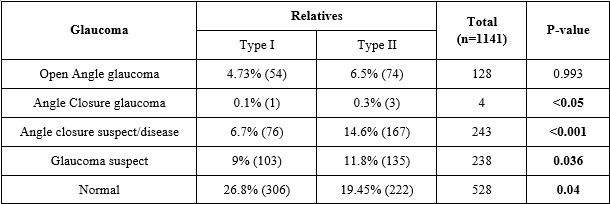Study of the importance of family screening of glaucoma: identifying the target
Abstract
Aim: To describe the value and results of family screening of glaucoma patients in the glaucoma clinic of a tertiary center in the Garhwal Himalayan region over a period of one year.
Material and Method: 300 patients underwent comprehensive ophthalmic examination and glaucoma examination including IOP measurement by Goldman applanation tonometry, binocular dilated fundoscopy with +90D Volk lens, gonioscopy using the 4 mirror Volk goniolens.
Results: 300 persons detected with primary glaucoma whose families were invited to participate in the family screening initiative, there were 114 first degree relatives who attended the screening with a response rate of 32%. The relatives of probands ranged in age from 18 to 89 years with 56.8% being males. 198 were diagnosed as primary angle-closure suspects, 8 as angle-closure,238 as glaucoma suspects and 132 subjects (11.6%) had definite glaucoma. Most affected subjects were in 40-70 years. The angle-closure disease was found more in females.
Conclusion: Study also found a higher prevalence of glaucoma in siblings; especially the angle-closure entity. Targeting first degree relatives of persons with primary glaucoma may offer a relatively inexpensive way of detecting glaucoma and in the identification of suspects at risk of glaucoma who may be advocated closer monitoring.
Downloads
References
Quigley HA, Broman AT. The number of people with glaucoma worldwide in 2010 and 2020. Br J Ophthalmol. 2006;90(3):262-267. doi: https://doi.org/10.1136/bjo.2005.081224.
Ramakrishna R, Nirmalan PK, Krishnada R, Thulasiraj RD, Tielsch JM, Katz J, et al. Glaucoma in a rural population of Southern India: the Aravind Comprehensive Eye Survey. Ophthalmol. 2003;110(8):1484-1490. doi: https://doi.org/10.1016/s0161-6420(03)00564-5.
Vijaya L, George R, Baskaran M, Arvind H, Raju P, Ramesh SV, et al. Prevalence of primary open angle glaucoma in an urban south Indian population and comparison with a rural population, The Chennai Glaucoma Study. Ophthalmol. 2008;115:648-54.e1. doi: https://doi.org/10.1016/j.ophtha.2007.04.062.
Tielsch JM, Katz J, Sommer A, Quigley HA, Javitt JC. Family history and risk of primary open angle glaucoma. The Baltimore Eye Survey. Arch Ophthalmol. 1994;112(1):69-73. doi: https://doi.org/10.1001/archopht.1994.01090130079022.
Leske MC, Connell AM, Wu SY, Nemesure B, Li X, Schachat A, Hennis A. Incidence of open-angle glaucoma: the Barbados Eye Studies. The Barbados Eye Studies Group. Arch Ophthalmol. 2001;119(1):89-95.
Nemesure B, Leske MC, He Q, Mendell N. Analyses of reported family history of glaucoma: a preliminary investigation. The Barbados Eye Study Group. Ophthalmic Epidemiol. 1996;3(3):135-141. doi: https://doi.org/10.3109/09286589609080119.
Leighton DA. Survey of the first-degree relatives of glaucoma patients. Trans Ophthalmol Soc UK. 1976;96(1):28–32.
Wolfs RC, Klaver CC, Ramrattan RS, van Duijn CM, Hofman A, de Jong PT. Genetic risk of primary open-angle glaucoma. Population-based familial aggregation study. Arch Ophthalmol.1998;116(12):1640-1645. doi: https://doi.org/10.1001/archopht.116.12.1640.
Nguyen RL, Raja SC, Traboulsi EI. Screening relatives of patients with familial chronic open angle glaucoma. Ophthalmol. 2000;107(7):1294–1297. doi: https://doi.org/10.1016/s0161-6420(00)00156-1.
Venkatesh R, Ramulu PY, Kavitha S, Sinha A, Wojciechowski R, Chan ES, Friedman DS. The Importance of Family History in Angle Closure Glaucoma. Invest Ophthalmol Visual Sci. 2012;53(14):4507.
Rajendrababu S, Gupta N, Vijayakumar B, Kumaragurupari R, Krishnadas SR. J Curr Glaucoma Pract. 2014;8(3):107–112. doi: https://dx.doi.org/10.5005%2Fjp-journals-10008-1172.

Copyright (c) 2020 Author (s). Published by Siddharth Health Research and Social Welfare Society

This work is licensed under a Creative Commons Attribution 4.0 International License.


 OAI - Open Archives Initiative
OAI - Open Archives Initiative



















 Therapoid
Therapoid

